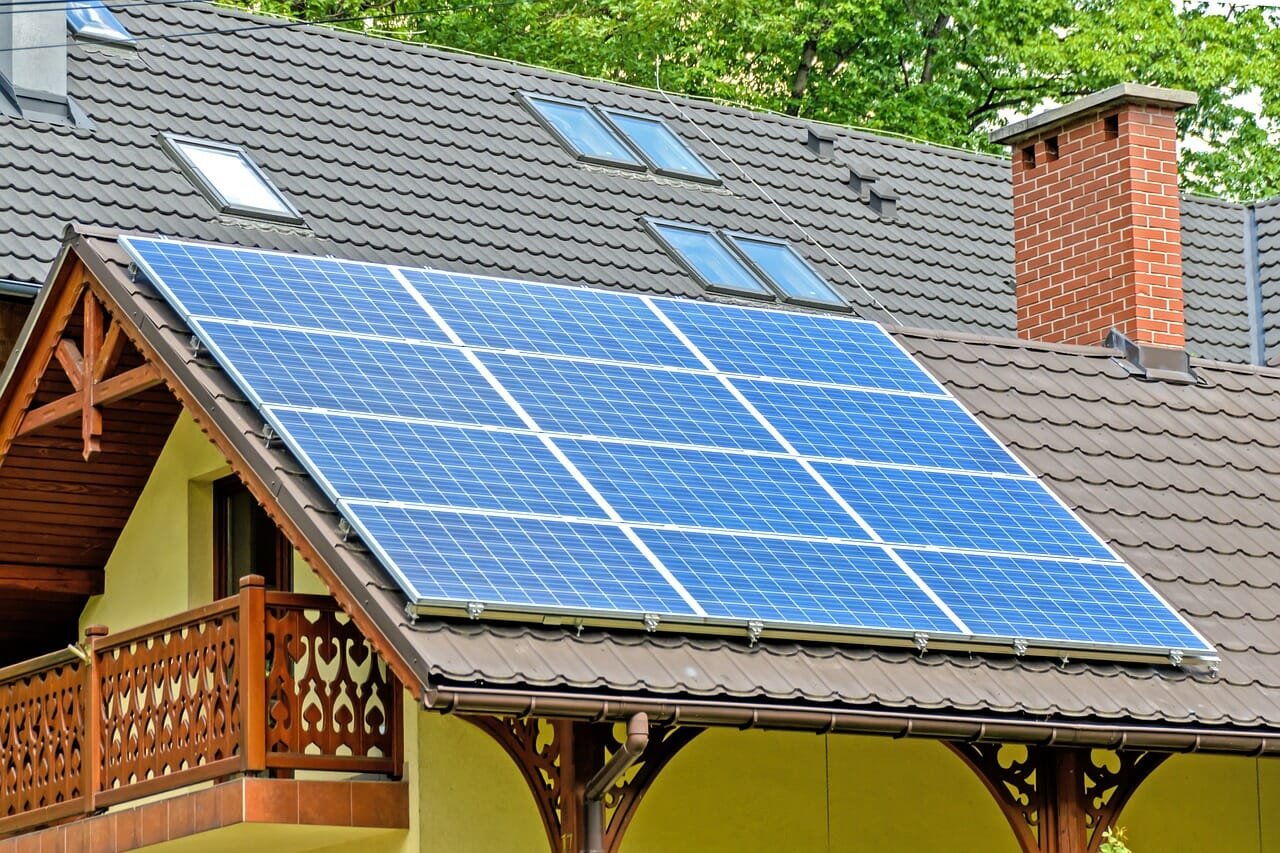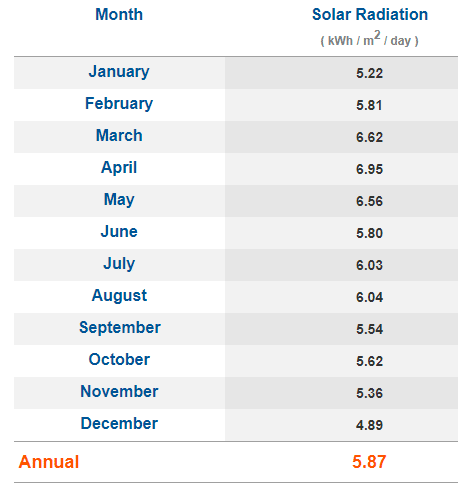
Wondering how much power or electricity will a 3kW solar panel produce? So you my friend have come to the right place.
This is going to be a thorough guide on how much DC and AC power output you can expect from a 3kW solar system according to your location.
Also, I'm gonna share some tips on how you can get the maximum output from your solar panels.
Need a simple solution? Use my free online solar panel output calculator to find out the power output of your solar system. Or use the chart below to find out the estimated output
Solar Panel Output Calculator
Note: Peak sun hours are not the total daylight hours. Click here to read about peak sun hours
How Much Power Does a 3kW Solar System Produce?

3kW solar system will produce about 12kWh of electricity or power per day, 360kWh per month, or 4,380kWh per year. Considering 5 hours of average peak sunlight per day.
Now let's discuss how many hours of peak sunlight your location receives and how to calculate.
How To Calculate Peak Sun Hours?

Only under standard conditions, solar panels will produce their rated wattage output.. which includes, 1kW/meter2 of sunlight intensity, 25oC temperature, no wind, and direct tilt angle.
That is why we consider peak sun hours as the baseline when estimating the solar system output.
The intensity of the sunlight will be different throughout the day like for example.
- Noon: 1000 watt/meter2 sunlight intensity (1 peak sun hour)
- late evening: 200 watt/meter2 sunlight intensity (0.2 peak sun hour)
To find out the total number of peak sun hours your location receives using this calculator.
Step 1: Enter Your Address

Step 2: Click Results

After selecting the result session you'll be able to see the number of peak sun hours per day, month by month.

These are the result from Florida city where i live. As you can see the average number of peak sun hours is about 5.87 or 5.87kWh/meter2 of solar radiations per day.
Average Solar Panel Output
you have a 3kw solar system so it should produce 3kWh in 1 peak sun hour? well, not exactly.
Yes, sometimes you'll receive 3kW of power output from your solar system but it will last for a few minutes.
Some days you may get more power output and some days it'll be lower. This will totally depend on the weather conditions.
and also there will be some power losses in DC cables and in charge controller.
Speaking from experience. on average, i receive about 70-80% output from my 400-watt solar panels per peak sun hour. This conclusion is based on 30 days of output data.
Related Post: Solar Panel Output Calculator – Average Solar Panel Output?
DC vs AC Output
All the numbers which i have talked about above are DC output (Direct current).
Solar panels produce power in DC and also batteries store power in DC, in simple words lower voltage.
but most of our household appliances required AC (alternating current). so to convert DC into AC we use an inverter.
As nothing is perfect when it comes to solar power or electricity in general. Solar power inverters are not 100% efficient.
This means there will be some percent power loss when converting DC into AC. Most solar panels are about 90% efficient.
This means a 10% of power loss will occur when converting DC - AC.
Related Post: Solar DC Watts To AC Watts Calculator & Formula
How To Calculate Power Output Of The Solar System?

Here are simple steps to calculate the power output from your solar system.
i would take a 3kW solar system and my city as an example (Florida city). Which receives on average 5.8 hours of peak sunlight per day.
5.8 * 3000 = 17,400WhNow multiply the value by 0.8 to subtract the power losses.
17,400 * 0.8 = 13,920Wh (DC) Now let's convert the DC watt into AC, considering a 90% efficient inverter.
13,920 * 0.9 = 12,520Wh (AC)in Florida, on average you'd receive about 14kWh DC and 12.5kWh AC power output from a 3kW solar system per day.
Related Post: What Can a 3kW Solar System Run?
3kW Solar System Output State By State - Chart
Here's a chart on how much power output you can expect from a 3kW solar system in your state.
| State | Average Peak Sun Hours (per day) | Estimated Output From 3kW Solar System (per day) | Estimated Output From 3kW Solar System (per month) | Estimated Output From 3kW Solar System (per year) |
|---|---|---|---|---|
| Alabama | 5.3 hrs | 12.7 kWh | 381 kWh | 4572 kWh |
| Alaska | 3.3 hrs | 7.9 kWh | 237 kWh | 2844 kWh |
| Arizona | 6.2 hrs | 14.8 kWh | 444 kWh | 5328 kWh |
| Arkansas | 5.1 hrs | 12.2 kWh | 366 kWh | 4392 kWh |
| California | 5.8 hrs | 13.9 kWh | 417 kWh | 5004 kWh |
| Colorado | 5.9 hrs | 14.1 kWh | 423 kWh | 5076 kWh |
| Connecticut | 4.7 hrs | 11.2 kWh | 336 kWh | 4032 kWh |
| Delaware | 4.9 hrs | 11.7 kWh | 351 kWh | 4212 kWh |
| Florida | 5.6 hrs | 13.4 kWh | 402 kWh | 4824 kWh |
| Georgia | 5.3 hrs | 12.7 kWh | 381 kWh | 4572 kWh |
| Hawaii | 5.0 hrs | 12.0 kWh | 360 kWh | 4320 kWh |
| Idaho | 5.1 hrs | 12.2 kWh | 366 kWh | 4392 kWh |
| Illinois | 6.5 hrs | 15.6 kWh | 468 kWh | 5616 kWh |
| Indiana | 4.7 hrs | 11.2 kWh | 336 kWh | 4032 kWh |
| Iowa | 4.8 hrs | 11.5 kWh | 345 kWh | 4140 kWh |
| Kansa | 4.5 hrs | 10.8 kWh | 324 kWh | 3888 kWh |
| Kentucky | 4.8 hrs | 11.5 kWh | 345 kWh | 4140 kWh |
| Louisiana | 5.4 hrs | 12.9 kWh | 387 kWh | 4644 kWh |
| Maine | 4.4 hrs | 10.5 kWh | 315 kWh | 3780 kWh |
| Maryland | 4.9 hrs | 11.7 kWh | 351 kWh | 4212 kWh |
| Massachusetts | 4.3 hrs | 10.3 kWh | 309 kWh | 3708 kWh |
| Michigan | 4.2 hrs | 10.0 kWh | 300 kWh | 3600 kWh |
| Minnesota | 4.5 hrs | 10.8 kWh | 324 kWh | 3888 kWh |
| Mississippi | 5.3 hrs | 12.7 kWh | 381 kWh | 4572 kWh |
| Missouri | 4.9 hrs | 11.7 kWh | 351 kWh | 4212 kWh |
| Montana | 4.4 hrs | 10.5 kWh | 315 kWh | 3780 kWh |
| Nebraska | 5.3 hrs | 12.7 kWh | 381 kWh | 4572 kWh |
| Nevada | 5.7 hrs | 13.6 kWh | 408 kWh | 4896 kWh |
| New Hampshire | 4.7 hrs | 11.2 kWh | 336 kWh | 4032 kWh |
| New Jersey | 4.7 hrs | 11.2 kWh | 336 kWh | 4032 kWh |
| New Mexico | 6.4 hrs | 15.3 kWh | 459 kWh | 5508 kWh |
| New York | 4.5 hrs | 10.8 kWh | 324 kWh | 3888 kWh |
| North Carolina | 5.2 hrs | 12.4 kWh | 372 kWh | 4464 kWh |
| North Dakota | 4.5 hrs | 10.8 kWh | 324 kWh | 3888 kWh |
| Ohio | 4.5 hrs | 10.8 kWh | 324 kWh | 3888 kWh |
| Oklahoma | 5.4 hrs | 12.9 kWh | 387 kWh | 4644 kWh |
| Oregan | 4.4 hrs | 10.5 kWh | 315 kWh | 3780 kWh |
| Pennsylvania | 4.7 hrs | 11.2 kWh | 336 kWh | 4032 kWh |
| Rhode Island | 4.7 hrs | 11.2 kWh | 336 kWh | 4032 kWh |
| South Carolina | 5.3 hrs | 12.7 kWh | 381 kWh | 4572 kWh |
| South Dakota | 5.0 hrs | 12.0 kWh | 360 kWh | 4320 kWh |
| Tennessee | 4.9 hrs | 11.7 kWh | 351 kWh | 4212 kWh |
| Texas | 5.7 hrs | 13.6 kWh | 408 kWh | 4896 kWh |
| Utah | 5.4 hrs | 12.9 kWh | 387 kWh | 4644 kWh |
| Vermont | 4.3 hrs | 10.3 kWh | 309 kWh | 3708 kWh |
| Virginia | 5.0 hrs | 12.0 kWh | 360 kWh | 4320 kWh |
| Washington | 4.8 hrs | 11.5 kWh | 345 kWh | 4140 kWh |
| West Virginia | 4.5 hrs | 10.8 kWh | 324 kWh | 3888 kWh |
| Wisconsin | 4.5 hrs | 10.8 kWh | 324 kWh | 3888 kWh |
| Wyoming | 5.4 hrs | 12.9 kWh | 387 kWh | 4644 kWh |
How To Get The Maximum Output From Your Solar System?
Before getting into how you can maximize the output performance of your solar panels. first of all, let’s discuss what factors affect the power output.
As i have discussed earlier. Only under specific conditions, a solar panel will produce their rated power output.
Other than those conditions there are some other factors that will affect the output.
Which includes...
- Dirt or dust on the solar panels
- DC cable losses
- Charge controller inefficiency
- Tilt angle
Which in the real world is rarely gonna happen. but we can do some steps to make sure that we’re getting the most from our solar system.
Here are some things which you can do to increase the output from your solar system.
- Clean your solar panels from time to time
- Use the right size DC cables
- Keep the shorter distance between solar panels, the charge controller, and the batteries
- Install your solar panels at a right tilt angle (use this calculator to find out)
- Use an MPPT charge controller
Watch this video to check the effect of tilt angle on solar panels output.
Other Useful Posts
- What Can a 3kW Solar System Run?
- How Many Solar Panels For (100, & 200 amp) Service
- What Will An Inverter Run & For How Long?
I hope this short guide was helpful to you. still, have any confusion? LEAVE A COMMENT or contact us. Thank You!


